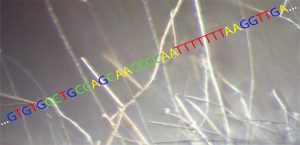In this post, Alexander Feckler talks about his recently published paper “Quantitative real-time PCR as a promising tool for the detection and quantification of leaf-associated fungal species – A proof-of-concept using Alatospora pulchella”.
A specific group of fungi, namely aquatic hyphomycetes, is known to play an important role during leaf litter decomposition in streams. These microorganisms are negatively affected by contaminants such as fungicides and pharmaceuticals, making them suitable bioindicators for anthropogenic stress. The traditional technique to estimate the impact of anthropogenic stress on fungal communities, based on microscopical assessment, can be misleading due to its reliance on a reproductive life stage and due to analogous morphology of spores from different species. Additionally, it only gives information on the presence of species but not on their individual biomasses. Molecular techniques such as quantitative real-time PCR (qPCR) may circumvent these shortcomings, as it allows both identification and quantification of individual species by correlating gene copy numbers with fungal biomass.

Hyphae of Alatospora pulchella and the gene sequence used for the developed assay (Photo by P. Baudy)
Our study reports the development of a species-specific qPCR assay that allows accurate quantification of the DNA (used as a proxy for biomass) of the aquatic hyphomycete Alatospora pulchella. The assay was validated against pure cultures of 24 hypomycete species and further applied to leaf material colonized by up to 14 hypomycete species to test for its specificity in environmental samples.
The results showed true-positive detections only for the target species A. pulchella with a high sensitivity and reliable quantification of its gene copy numbers. Our method exhibited high specificity: neither genetically nor morphologically closely related species present in the same sample gave a positive signal. These outcomes were confirmed when applying the assay to environmental samples with diverse communities of aquatic hyphomycetes and bacteria as well as substances that may inhibit the process of DNA amplification. Such findings establish qPCR as a promising tool for a species-specific identification and quantification of microorganisms involved in leaf litter decomposition, allowing more accurate and thorough investigation of their ecology and evolution.
The paper was authored by Alexander Feckler, Anne Schrimpf, Mirco Bundschuh, Felix Bärlocher, Patrick Baudy, Julien Cornut, and Ralf Schulz, and published open access in PLoS ONE.
Interested in a bachelor or master thesis on this topic? We are currently working on qPCR assays for further aquatic hyphomycete species and use these assays to assess the effects of inter alia chemical contaminants on communities of these fungi. Sounds interesting to you? Then do not hesitate to contact us:
Patrick Baudy (baudy@uni-landau.de) & Jochen Zubrod (zubrod@uni-landau.de)
